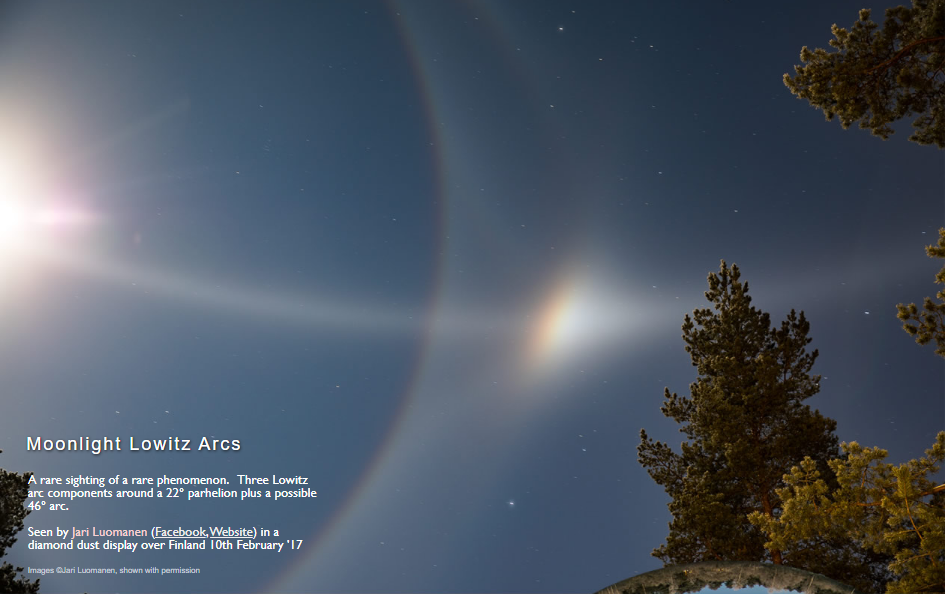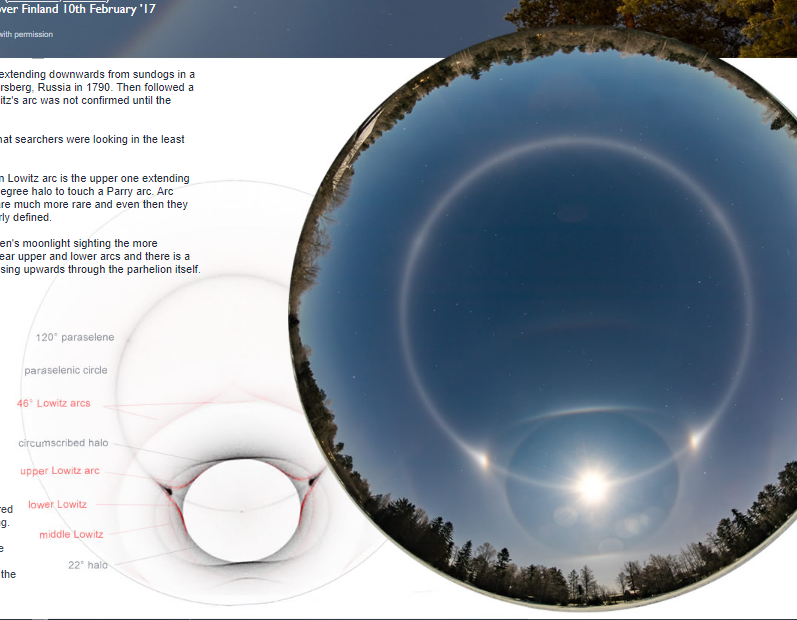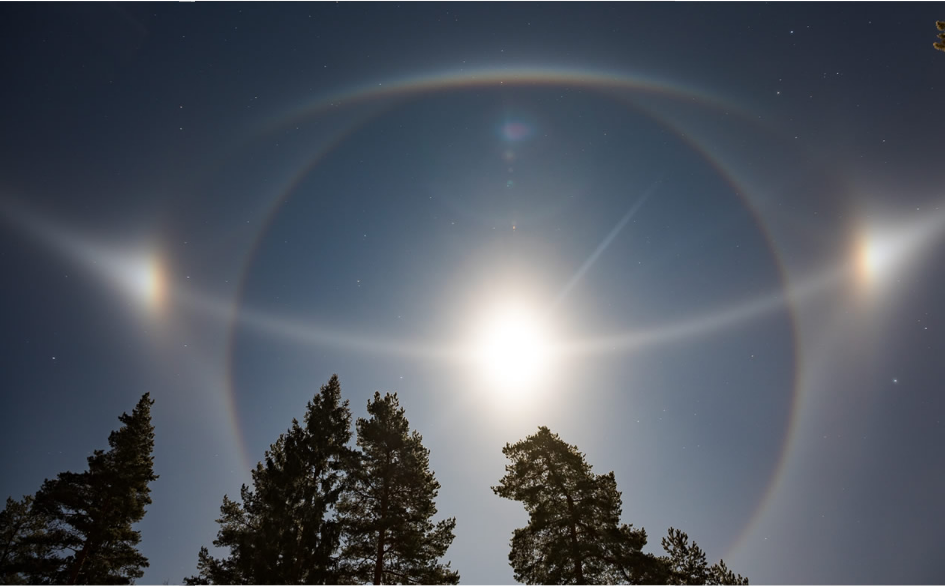Lunar Lowitz Arcs
Lunar Lowitz Arcs: A Rare and Spectacular Atmospheric Phenomenon
Atmospheric optics never cease to amaze us with their stunning displays of light and color. One such phenomenon is the Lunar Lowitz Arcs, a rare sighting that captivates skywatchers with its unique characteristics. While these arcs were first observed in 1790 by Tobias Lowitz, it wasn't until the 1990s that they were confirmed and properly understood. Today, we will delve into the intriguing world of Lunar Lowitz Arcs, exploring their formation, characteristics, and the recent remarkable sighting by Jari Luomanen over Finland.
The Enigmatic Lowitz Arc
The most commonly observed Lowitz arc is the upper one, extending above the top of the 22-degree halo to touch a Parry arc. However, sightings of arcs near sundogs are much rarer and often faint and poorly defined. This scarcity of observations contributes to the enigmatic nature of the Lowitz arc, making each sighting all the more special.
Jari Luomanen's Spectacular Moonlight Sighting
In February 2017, Jari Luomanen had the privilege of witnessing a truly breathtaking display of Lunar Lowitz Arcs during a diamond dust event in Finland. The sighting was particularly remarkable due to the presence of clear upper and lower arcs, as well as a rare faint middle arc passing upwards through the parhelion itself. This unique combination made Luomanen's moonlight sighting an extraordinary event in the realm of atmospheric optics.
Unraveling the Formation of Lunar Lowitz Arcs
To understand the formation of Lunar Lowitz Arcs, we must delve into the intricate interactions between light and ice crystals in the atmosphere. These arcs are believed to be created by plate-shaped ice crystals with specific orientations. As light passes through these crystals, it undergoes refraction and reflection, leading to the formation of the distinctive arcs.
The Role of Plate Crystal Orientation
Plate crystals play a crucial role in the formation of Lunar Lowitz Arcs. The bright colored arc near the zenith observed in Luomanen's sighting might be a 46° Lowitz arc, formed by rays passing between the basal and side faces of Lowitz-oriented plate crystals. These specific orientations are essential for the creation of this rare atmospheric phenomenon.
The Importance of Atmospheric Conditions
The occurrence of Lunar Lowitz Arcs is heavily dependent on specific atmospheric conditions. Diamond dust events, like the one witnessed by Luomanen, provide an ideal environment for the formation of these arcs. Diamond dust consists of tiny ice crystals suspended in the air, creating a stunning display of shimmering particles that interact with light in fascinating ways.
Advancements in Understanding
While the first observation of Lowitz arcs dates back to the late 18th century, it took centuries for their existence to be confirmed and properly understood. Thanks to advancements in technology and scientific research, we now have a deeper understanding of the mechanisms behind these arcs. Tools like HaloSim ray tracing allow us to simulate and visualize the formation of Lowitz arcs, shedding light on their intricate characteristics.
A Sight to Cherish
The rarity and beauty of Lunar Lowitz Arcs make each sighting a moment to cherish. The combination of upper, lower, and middle arcs creates a captivating celestial spectacle that leaves observers in awe. To witness these arcs amidst a moonlit backdrop, as Jari Luomanen did, adds an ethereal touch to an already mesmerizing phenomenon.
Capturing the Magic
Photographing Lunar Lowitz Arcs can be a challenging endeavor due to their faint nature and specific atmospheric conditions required for their formation. However, with patience, persistence, and a keen eye for atmospheric optics, photographers can capture the magic of these elusive arcs. Each photograph serves as a testament to the wonder and intricacy of our natural world.
The Ongoing Quest for Knowledge
While our understanding of Lunar Lowitz Arcs has greatly expanded in recent years, there is still much to learn about these elusive atmospheric phenomena. Continued research and observations will undoubtedly contribute to our knowledge of their formation, characteristics, and the specific atmospheric conditions required for their occurrence. As sky enthusiasts continue to explore the mysteries of our atmosphere, we can look forward to more insights into the captivating world of Lunar Lowitz Arcs.
A Reminder of Nature's Splendor
Lunar Lowitz Arcs serve as a reminder of the awe-inspiring beauty that surrounds us in the natural world. These rare and remarkable atmospheric optics phenomena remind us of the complexity and wonder that exists above our heads. So, the next time you find yourself gazing at the night sky, take a moment to appreciate the intricate dance of light and ice crystals that creates such breathtaking displays. The celestial canvas above us never fails to astound and inspire.

Moonlight Lowitz ArcstopticsAHighlightsAtoptics Highlights - Optics Picture of the Day - OPOD - Atmospheric Optics A rare sighting of a rare phenomenon. Three Lowitz arc components around a 22° parhelion plus a possible 46° arc.
Seen by Jari Luomanen (Facebook, Website) in a diamond dust display over Finland 10th February '17
Images ©Jari Luomanen, shown with permission

Tobias Lowitz drew arcs extending downwards from sundogs in a halo display over St Petersberg, Russia in 1790. Then followed a long interregnum for Lowitz's arc was not confirmed until the 1990s.
One possible reason is that searchers were looking in the least favourable place.
The most commonly seen Lowitz arc is the upper one extending above the top of the 22 degree halo to touch a Parry arc. Arc sightings near sundogs are much more rare and even then they are usually faint and poorly defined.
That makes Jari Luomanen's moonlight sighting the more spectacular. There are clear upper and lower arcs and there is a rarer faint middle arc passing upwards through the parhelion itself.
The bright coloured arc near the zenith might be a 46° Lowitz arc from rays passing between basal and side faces of Lowitz oriented plate crystals.

Lowitz arcs are drawn in red on this HaloSim ray tracing. To show the middle arc, relatively thick plates were used with restricted rotational positions about the Lowitz axis.
Lowitz arcs��������������� �� Tobias Lowitz 1790 display
Most often seen Lowitz arcs
46° Lowitz arcs����������������� https://atoptics.co.ukHaloSim
Note: this article has been automatically converted from the old site and may not appear as intended. You can find the original article here.
Reference Atmospheric Optics
If you use any of the definitions, information, or data presented on Atmospheric Optics, please copy the link or reference below to properly credit us as the reference source. Thank you!
-
<a href="https://atoptics.co.uk/blog/lunar-lowitz-arcs/">Lunar Lowitz Arcs </a>
-
"Lunar Lowitz Arcs ". Atmospheric Optics. Accessed on November 24, 2024. https://atoptics.co.uk/blog/lunar-lowitz-arcs/.
-
"Lunar Lowitz Arcs ". Atmospheric Optics, https://atoptics.co.uk/blog/lunar-lowitz-arcs/. Accessed 24 November, 2024
-
Lunar Lowitz Arcs . Atmospheric Optics. Retrieved from https://atoptics.co.uk/blog/lunar-lowitz-arcs/.